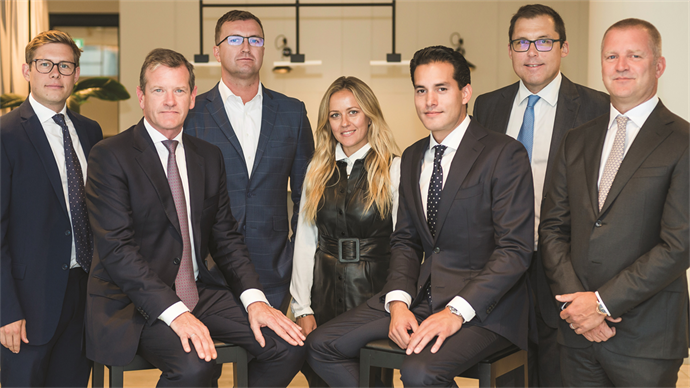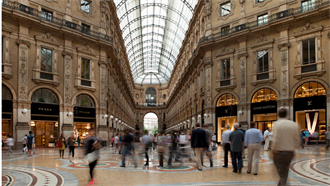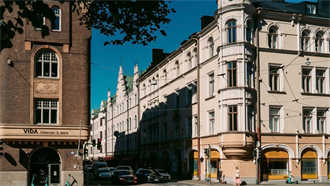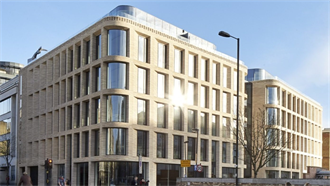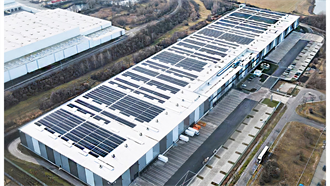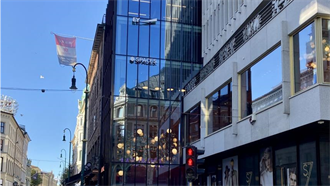Logistics experts assembled at PropertyEU’s HQ in Utrecht last month for a roundtable discussion on one of the hottest asset classes in Europe right now.
Europe’s logistics and industrial property sector is booming. ‘It’s a great place to be at the moment. And for us it has obviously been fantastic for the last few years,’ said Ben Bannatyne, president of Prologis Europe, during introductory remarks to PropertyEU’s logistics roundtable event which was held in early September and attended by seven market experts.
Across Europe, all 12 of Prologis’ markets have been performing well – even the UK despite political turbulence. ‘I was there yesterday actually, and there is still a huge amount of activity and customer demand,’ Bannatyne remarked. ‘It is still incredibly strong. But I think right across all 12 countries we are present in activity is good.’
Over a private discussion lasting one-and-a half hours, the seven participants rovided a unique insight into the present-day logistics and industrial market. The starting point was how this sector has come to be in such rude health. Philip Dunne, head of EMEA logistics at CBRE Global Investors, says the sector has been in the ‘sweet spot’ for five years, but the first shoots of recovery go back to 2012 when businesses started to recapitalise.
The initial picture back then was bleak, and it required years of clean-up following the Global Financial Crisis of 2008 as the sector dealt with a huge overhang of supply and a need to recapitalise leases. Valuers – not always the quickest to reflect actualities – had finally conceded to the position of the market, and values were on the floor. But brave moves were made by some major owners of logistics and industrial property to cut rents and reduce debt.
As occupiers began to see cheaper prices for space, some took the opportunity to upgrade their premises and reconfigure their supply chain, which in turn eventually gave developers the confidence to start up again from 2015 onwards. ‘The recovery has seen a very, very long tail,’ Dunne summed up, adding that CBRE GI’s logistics has commensurately reached €9 bn of assets and has just been getting bigger.
Nick Preston, fund manager at Tritax Euro-Box, said the turbo-charged recovery outlined by Dunne coincided with Tritax launching a UK fund that ‘really caught the upswing’ as yields dropped, and rents started to rise.
ONLINE ADVANCE
But probably the biggest single positive driver in the sector, Preston noted, has been online retailing. ‘The demand from the occupier has been going up and up solidly, and it’s very much in step with ecommerce and the supply of online retail spending,’ he said. Bannatyne said that pre-crisis, Amazon acted as the bellwether for ecommerce and since then it has ‘absolutely mushroomed’.
‘Every other retailer has been figuring out how to add ecommerce to its physical store offer. John Lewis of the UK is a perfect example as 35% of its total sales are online driving growth, and 53% of orders are for click and collect. Every single retailer that wants to stay in business has had to adapt and will have to continue to figure out how to penetrate that part of the market,’ he said.
Marcus de Minckwitz, director regional investment advisory EMEA at Savills, used to be a retail specialist in the UK before crossing over to cover European logistics. Savills research suggests in the UK online sales are approaching 20% of total sales whilst in Europe this figure is far lower at less than 10% on average.
‘The growth forecasts across Europe combined with what has happened in the UK logistics market in the last five years since it passed that 10% figure is framing the opportunity on the continent,’ he said, adding: ‘Prologis highlighted in 2015 that, in the US, for every billion dollars of extra spend online, about 75,000 m2 of additional warehouse space was required. As we have watched online retail grow in the UK then we actually think this figure has been more like 100,000 m2. If you extrapolate that over the next five years in Europe and just look at relatively conservative straight-line growth forecasts for online spending, it means about 15 million m2 of additional warehouse space will be required to supply growing online spending alone.’
Panattoni Europe has played its part in the recovery story with a particular focus on the CEE region. Its CEO Robert Dobrzycki says that from 2012 onwards the company was extremely busy even without ecommerce. Growth was manufacturing-driven in markets such as Poland, the Czech Republic and Slovakia. This propelled developers to assemble huge portfolios even when ecommerce
was not very active. Free movement of goods and labour and the absence of trade borders between Central and Western Europe have altered the logistics landscape. Labour costs can be up to four times cheaper in Poland or the Czech Republic than Germany
‘It is such a difference in costs it might as well be a different planet,’ Dobrzycki said. Labour costs have contributed massively to a natural flow of business from Western Europe and Germany to parts of eastern Europe and explain why Panattoni has developed centres for Amazon in Poland and the Czech Republic.
‘The market has doubled within the last few years in terms of stock, that’s how dramatic it has been,’ Dobrzycki noted. ‘Now we see ecommerce, which is not only focused on the Central European markets but serving Western markets like Germany.’
Ekaterina Avdonina, founder and CEO of Mirastar, observed how ecommerce still constitutes a relatively low percentage of overall logistics and manufacturing demand. She highlighted how occupiers have been centralising and consolidating into single XXL warehouse formats to drive efficiency. That has spurred relocation from old to newer premises.
‘It is not only ecommerce driving demand,’ she said. ‘There exists a very sophisticated occupier base that knows the supply chain and how to drive efficiencies.’ And what constitutes a ‘good location’ has fundamentally altered, she explained. ‘It used to be location, location, location, but now it is how close it is to a metropolitan area and power supply. Some locations in London pre-ecommerce days have become obsolete because they don’t have enough power or labour.’
Tritax’s Preston agreed. Manufacturers and the way they are working with their suppliers and 3PLs to achieve speedier delivery times are contributing to bigger formats.
That said, how to improve efficiency is being led by online retailers. This focus on efficiency has resulted in some polarisation in demand between XXL logistics and last-mile delivery locations. This is why XXL formats and last-mile facilities are two ‘real growth areas’, said Preston. And a shortage of available final-mile sites is leading to rental growth. ‘Whenever you talk to a developer, the problems they raise are inevitably shortage of and to build the next site,’ Preston said. ‘n particular, there is a shortage of the very big plots where there is a requirement for a 100,000 m2 logistics unit, as was the case for a unit built for Castorama that we bought from Panattoni.’
De Minckwitz said Savills has adapted its advice on what constitutes a good location. Whereas it used to be about homogenous sheds, a good property is much more about a building’s good ‘trade or supply chain pro-file’ considering key inputs including labour, transport and the latest big one – energy.
His Savills colleague, Douglas van Oers, who is an expert on the Dutch logistics sector, described how the sector in the Netherlands is playing ‘catch up’ with markets such as the UK and Germany. Growth in the Netherlands has been ‘exponential’, he said. It used to be that 30 hectares of land would require a 10-year plan before every piece of land was taken up, he explained. Now, just two developers will come along and take half of it.
‘So, there is something that has fundamentally changed in the market. Also, the standard size: in the past, a big warehouse would be considered to be over 10,000 m2 but not anymore. We are also seeing a shift from established locations to locations which are important from another point of view.’
Bleiswijk in the western Netherlands is a prime example, having become a good yet under-valued location with plenty of available land that no one looked at 10 years ago. German online retailer Zalando is building a 140,000 m2 fulfilment centre there. Prologis’ Bannatyne said that in a good market for logistics real estate, all locations tend to work fine. But when the market does eventually soften, he believes a number of locations will not work so well. ‘I see plans on the drawing board all the time. People are making money, so why not? But long term there clearly will be locations that will suffer if the market slows down. The locations that will continue to perform are those close to populations and infrastructure.’
Though XXL formats are clearly mushrooming, Bannatyne pointed out that Prologis’ average lease for space happens to be way below 10,000 m2. Strong demand is coming from ecommerce and everything that is driven by e-commerce including UK data centres. But in general, he sees demand across industries. Supply constraints and strong demand are leading to investment prices being paid for some assets at yields below 4%.
The roundtable mentioned the sale of three Amazon-occupied properties which were sold to Korean investors. Even though such keen yields are being witnessed, no one around the table seems surprised. ‘With negative-yielding government bonds should anything surprise us?’ Mirastar’s Avdonina asked. ‘German 10- year bonds are minus 70 basis points as of
today. US bond rates are also sub zero and moved 60 basis points in one month. If you are a Korean buyer and put a good FX (foreign exchange) on it, you can get very attractive cash-on-cash returns.’
YIELD SQUEEZE
Turning from occupier demand to the prices being paid for assets, CBRE GI’s Dunne observed that the interesting dynamic is that supply and demand have not got out of equilibrium. Overall, he asserted, developers have maintained a lot more discipline compared to 2006 and the message from occupiers is: ‘continue driving for structural con-solidation, ecommerce and everything else’.
He said: ‘And remember, these jumbo facilities create demand for smaller facilities around them. But that demand will not last in perpetuity. There will be some sort of change. All of the economists are saying we are in a very slow, low growth environment for the next five years or so. We have monetary policy which has done a massive U-turn and interest rates that are likely to remain low for a very long time and money pouring into real estate as an alternative asset class. Retail – no one wants it now. That will change in time, but you have a divergence of capital from retail to logistics. Now you have other money starting to pile in. New capital wanting logistics is pouring in on top of everything else. It is also a form of defensive asset class. And so now we are in this place where there is a shortage of product.’
This combination of factors is leading Dunne to suppose that if investors can get a 3% return, they will view this as still better than a 0% return. If an insurance company or pension fund can get even a 2% return to match liabilities, they will go for that too. ‘There is an interesting evolution of capital into long-term income funds,’ he said. ‘We actually set one up in the UK which has been very well received and has generated huge interest. Put all this together and yields will continue to come down oddly enough. I never thought I’d see the day.’
As a start-up firm, Goldman Sachs-backed Mirastar has built a platform with 14 people in three offices and will continue growing. Avdonina says these are exciting times with loads of opportunities, but also threats.
‘Logistics is still not immune from cyclicality down to the economy but it remains attractive for a lot of buyers,’ she said. ‘And I agree with Philip that we will still see yield compression as odd as that sounds. In my previous job we wrote a five-year business plan. Some of my old assets are now trading well below the number they were at. That’s just incredible.’
Panattoni’s Dobrzycki reminded the panel that Europe is not one place. Two years ago, the company entered the UK where he sees a slowdown in decision-making because of Brexit compared to the ‘amazing’ pace of Central Europe. His business continues to flourish thanks to demand for developments from the likes of Amazon, for whom it is increasingly working on last-mile delivery.
‘Small developers cannot assign resources to that kind of asset. This is a lot of work but a very attractive proposition for us,’ he said.
LAST MILE
Mention of last mile is like lighting a touch paper. Dunne seemed less than enthused that 90% of his conversations relate to last-mile logistics even though it’s a very small part of the universe. Bannatyne wryly observed that every bit of light industrial space close to a Prologis asset has turned ‘overnight’ into last mile, yet there are very few markets where such a thing is necessary, the exceptions being London and Paris.
Dunne voiced doubts about the costs of running smaller sites and whether it is possible to accumulate a platform of sufficient scale to justify the management and cost of them. He referred to Picnic, a new supermarket entrant to the Netherlands that is a tenant at a CBRE GI asset in Utrecht. Its online business unit in the city uses electric trucks.
‘That will mushroom and grow, but how many 1,000 m2 facilities are sitting right in the middle of a city with a population of one million and how many such assets do you need to accumulate to get to scale?’
Savills’ De Minckwitz said the firm actually acquired Uber’s congestion data telling it all about congestion and therefore last-mile needs. ‘You need last mile where it is really congested, and that is really only in two locations in Europe.’ By contrast, in the Netherlands last-mile logistics does not really exist because the road infrastructure is sogood. ‘That is true,’ added Van Oers. ‘Here in the Netherlands you can reach places in one hour. Of course, there are smaller hubs around city centres, but these are 1,200 m2 in size and there are not a lot of investors looking for this kind of size.’
One part of the industry that is definitely not overhyped is the requirements for crossdocks for parcel delivery, according to Avdonina. PostNL has shut down several hundred hubs across the Netherlands in the last five or six years, but over the same period the number of parcels has increased something like 50-fold. ‘They are handling astronomical volumes,’ she said.
‘With technology, we have changed not just from Next Day to Same Day but even to Next Hour delivery. I got a parcel in 65 minutes on Sunday from Amazon Prime. Why would anyone go to a shop? With that kind of cannibalising in retail, we are probably going to see even more requirements for bespoke facilities, and this is a real sub-sector of last mile.’
So far, transformation has only happened in a handful of sectors, Avdonina said. Fashion retailing has really been disrupted, for instance, but food retailing has not – yet.
‘Until the online sector figures out how to distribute fresh produce adequately quickly, you will not see a lot of logistics in that sector. But I think it is like a ticking bomb for a lot of retailers,’ she said.
‘I think big-format supermarkets are dying – or are dead – and have been for about 10 years,’ added Tritax’s Preston. ‘There are even three or four in the UK that didn’t even bother opening.’
Europe’s logistics and industrial property sector is booming. ‘It’s a great place to be at the moment. And for us it has obviously been fantastic for the last few years,’ said Ben Bannatyne, president of Prologis Europe, during introductory remarks to PropertyEU’s logistics roundtable event which was held in early September and attended by seven market experts.
Across Europe, all 12 of Prologis’ markets have been performing well – even the UK despite political turbulence. ‘I was there yesterday actually, and there is still a huge amount of activity and customer demand,’ Bannatyne remarked. ‘It is still incredibly strong. But I think right across all 12 countries we are present in activity is good.’
Over a private discussion lasting one-and-a half hours, the seven participants rovided a unique insight into the present-day logistics and industrial market. The starting point was how this sector has come to be in such rude health. Philip Dunne, head of EMEA logistics at CBRE Global Investors, says the sector has been in the ‘sweet spot’ for five years, but the first shoots of recovery go back to 2012 when businesses started to recapitalise.
The initial picture back then was bleak, and it required years of clean-up following the Global Financial Crisis of 2008 as the sector dealt with a huge overhang of supply and a need to recapitalise leases. Valuers – not always the quickest to reflect actualities – had finally conceded to the position of the market, and values were on the floor. But brave moves were made by some major owners of logistics and industrial property to cut rents and reduce debt.
As occupiers began to see cheaper prices for space, some took the opportunity to upgrade their premises and reconfigure their supply chain, which in turn eventually gave developers the confidence to start up again from 2015 onwards. ‘The recovery has seen a very, very long tail,’ Dunne summed up, adding that CBRE GI’s logistics has commensurately reached €9 bn of assets and has just been getting bigger.
Nick Preston, fund manager at Tritax Euro-Box, said the turbo-charged recovery outlined by Dunne coincided with Tritax launching a UK fund that ‘really caught the upswing’ as yields dropped, and rents started to rise.
FUTURE TRENDS
Savills’ Van Oers cited Uber Freight as another part of the supply chain that is rapidly evolving – using people to deliver products. His colleague pointed to ‘data use’ as another: if a business sells its goods through an Amazon facility it will also get access to Amazon’s data about customer behaviour which can be used further in supply chain optimisation. ‘That is the scary part of Amazon!’ said De Minckwitz. ‘And the Internet of Things,’ interjected Avdonina. ‘The fact that your fridge, printer and washing machine will talk to each other. Indeed, they are already. Hewlett Packard has an arrangement with Amazon to deliver cartridges, so I think the next big disruptor is the Internet of Things for offices and households.’
CBRE GI’s Dunne said exercising discipline would be a big challenge for logistics investors and developers. ‘Discipline is the most important thing. And equity tends to be more disciplined than debt. But when debt costs nothing, it can create a lack of discipline over time. So, the industry has some responsibility to try and manage that. But I think the macro environment suggests that we will be having a good run for the next three to five years.’
Savills’ Van Oers cited Uber Freight as another part of the supply chain that is rapidly evolving – using people to deliver products. His colleague pointed to ‘data use’ as another: if a business sells its goods through an Amazon facility it will also get access to Amazon’s data about customer behaviour which can be used further in supply chain optimisation. ‘That is the scary part of Amazon!’ said De Minckwitz. ‘And the Internet of Things,’ interjected Avdonina. ‘The fact that your fridge, printer and washing machine will talk to each other. Indeed, they are already. Hewlett Packard has an arrangement with Amazon to deliver cartridges, so I think the next big disruptor is the Internet of Things for offices and households.’
CBRE GI’s Dunne said exercising discipline would be a big challenge for logistics investors and developers. ‘Discipline is the most important thing. And equity tends to be more disciplined than debt. But when debt costs nothing, it can create a lack of discipline over time. So, the industry has some responsibility to try and manage that. But I think the macro environment suggests that we will be having a good run for the next three to five years.’
OUR PANEL
MARCUS DE MINCKWITZ is director regional investment advisory EMEA at Savills. Having spent 10 years in the UK business, the last five of which specialising in retail, he moved to the European team in January 2019 to focus on logistics.
PHILIP DUNNE joined CBRE Global Investors in May 2018. He is a seasoned logistics investor and operator, his prior role being president of Prologis Europe from 2008 until 2016.
ROBERT DOBRZYCKI is CEO of Panattoni in Europe and oversees the operations in Poland, Czech Republic, Slovakia, Germany, and the UK. He established Panattoni’s CEE operation in 2005.
EKATERINA AVDONINA is CEO of Mirastar, a new specialist pan-European developer, investor and manager of big box logistics assets with an exclusive mandate from Goldman Sachs. Mirastar is a joint venture between co-founders Avdonina, and CIO Anthony Butler, and M7 Real Estate, the pan-European
investor and asset manager.
DOUGLAS VAN OERS is co-head of logistics and industrial at Savills Netherlands. Clients include Prologis, Gramercy and Deka, and the firm has also represented logistics and industrial tenants such as CEVA, TNT and DB Schenker.
NICK PRESTON is fund manager, Tritax EuroBox plc, with overall responsibility for the provision of investment management and advisory services to the company. Prior to joining the Tritax Group in
September 2017, he worked for Grosvenor Europe in the positions of managing director (Europe) and head of portfolio.
BEN BANNATYNE is president of Prologis Europe and chairman of the company’s European Management Executive Committee. The logistics platform comprises 17 million m2 across 12 countries.

